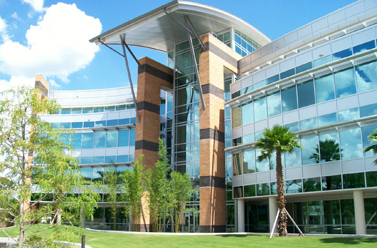Small Versus Big Schools: Grinnell College and the University of Central Florida
When it comes to selecting the right school, value isn't one-size-fits-all.

One school delivers its education the classic way, the other with an innovative approach that may just represent the future of education. Together, these two schools demonstrate the range of choices in our 2016 list of best college values. Here's what each has to offer.
Top Quality, Small Scale
It may not have the name recognition of a Harvard or Yale, but tiny Grinnell College, in central Iowa, attracts stellar students from around the country and the world for its broad-based liberal arts curriculum, tight-knit community and focus on social justice. "There are so many fixed ideas about which schools are the premier institutions," says Grinnell president Raynard S. Kington. "People are surprised to discover a diverse, accessible, Midwest-modest college in the middle of the prairie."
"Midwest-modest"—an amalgam of midwestern and small-town values—may be how Grinnell identifies itself, but make no mistake: Grinnell students are high achievers. Three-fourths of incoming freshmen score 30 or higher on the ACT. The school is a top producer of Fulbright scholars, and a high percentage of its undergraduates go on to earn a PhD. A fixture on Kiplinger's rankings for best value, Grinnell secures its spots on this year's lists (number nine on our liberal arts list and number 18 on our combined ranking) for its competitive acceptance rate (28%), low student-faculty ratio (nine to one) and generous financial aid (average need-based aid brings the net cost for families who qualify to$22,145 yearly).

Sign up for Kiplinger’s Free E-Newsletters
Profit and prosper with the best of expert advice on investing, taxes, retirement, personal finance and more - straight to your e-mail.
Profit and prosper with the best of expert advice - straight to your e-mail.
The school's campus, in the small town of Grinnell, was once a stop on the Underground Railroad. Today the tracks crossing through campus bring real trains (usually carrying corn syrup) a few times a day. Still, social activism continues to resonate with students. More than one-fourth of the 1,700 undergraduates major in social sciences, and many students, regardless of their academic interests, weave the school's emphasis on social justice into their research or internships.
Grinnell stresses self-governance. The school sets no formal degree requirements for any of its 27 majors; instead, students work with faculty to craft a plan of study. No matter which courses they pick, students enjoy small class sizes and plenty of face time with faculty and administrators. Professors, many of whom live near campus, sometimes host dinners for students at their homes. Kington, his spouse and their two sons, ages 6 and 9, usually eat dinner in the school dining hall at least once a week.
Like many of the schools on our best value list, Grinnell's sticker price flirts with the $60,000 mark. But thanks to financial aid programs, only about 15% of families pay full freight. Nearly 70% of students receive need-based aid. A robust merit-aid program awards funds to 45% of students who don't receive need-based aid (an average of $16,968 a year). "After financial aid, Grinnell cost less than half of what it would have cost me to attend the University of Colorado Boulder in-state," says junior Annie Casey. For students who borrow, the school typically limits loans to no more than 10% of the total cost of attendance, says Joe Bagnoli, dean of admission and financial aid.
Big School, Big Ambitions

Value isn't one-size-fits-all. For some students, a larger school is a better fit.
With more than 52,000 undergraduates, the University of Central Florida offers an expansive list of more than 100 undergraduate degree programs and an innovative teaching style that blends traditional classroom experience with online and semi-online instruction. The school earns its spot at number 36 on our public colleges list for in-state students (number 47 for out-of-state students) in part by keeping the cost of attendance well below the national average for both in-state and out-of-state students. And after need-based aid, the average annual total cost rings in at $12,115 for in-state students and $28,214 for out-of-staters.
This behemoth public research university, located on a sprawling 1,415 acres 13 miles east of downtown Orlando, uses its size to its advantage. "It allows us to offer a comprehensive list of academic disciplines. If we were a smaller campus we could be strong in, say, physics or optics, but not visual and performing arts or hospitality and tourism," says UCF provost Dale Whittaker. The school accepts half of applicants—many of whom are commuters or otherwise nontraditional students—and has increased undergraduate enrollment 90% since 2000. To accommodate the growth, UCF made an early push to offer online courses and allow students to pick the format of their classes. Last year, more than three-fourths of UCF students took at least one course online.
Get Kiplinger Today newsletter — free
Profit and prosper with the best of Kiplinger's advice on investing, taxes, retirement, personal finance and much more. Delivered daily. Enter your email in the box and click Sign Me Up.

-
 Registered Social Security Analyst: The Retirement Professional You Didn’t Know You Needed
Registered Social Security Analyst: The Retirement Professional You Didn’t Know You NeededThe services of a Registered Social Security Analyst (RSSA) are often overlooked. Yet, for those planning for retirement, nearing or already retired, an RSSA can be an invaluable resource.
By Donna LeValley
-
 Should You Hire a Public Adjuster for Your Insurance Claim?
Should You Hire a Public Adjuster for Your Insurance Claim?As natural disasters strike more often, insurance clients are asking, 'What should I do, or who should I hire, if my insurance company is jerking me around?'
By H. Dennis Beaver, Esq.
-
 Roth IRA Contribution Limits for 2025
Roth IRA Contribution Limits for 2025Roth IRAs Roth IRA contribution limits have gone up. Here's what you need to know.
By Jackie Stewart
-
 Four Tips for Renting Out Your Home on Airbnb
Four Tips for Renting Out Your Home on Airbnbreal estate Here's what you should know before listing your home on Airbnb.
By Miriam Cross
-
 Five Ways to a Cheap Last-Minute Vacation
Five Ways to a Cheap Last-Minute VacationTravel It is possible to pull off a cheap last-minute vacation. Here are some tips to make it happen.
By Vaishali Varu
-
 How to Figure Out How Much Life Insurance You Need
How to Figure Out How Much Life Insurance You Needinsurance Instead of relying on rules of thumb, you’re better off taking a systematic approach to figuring your life insurance needs.
By Kimberly Lankford
-
 Amazon Big Deal Days Is Coming! We’ve Got All the Details
Amazon Big Deal Days Is Coming! We’ve Got All the DetailsAmazon Prime To kick off the holiday season with a bang, Amazon Big Deal Days runs Tuesday, October 8 and Wednesday, October 9.
By Bob Niedt
-
 How to Shop for Life Insurance in 3 Easy Steps
How to Shop for Life Insurance in 3 Easy Stepsinsurance Shopping for life insurance? You may be able to estimate how much you need online, but that's just the start of your search.
By Kaitlin Pitsker
-
 Five Ways to Shop for a Low Mortgage Rate
Five Ways to Shop for a Low Mortgage RateBecoming a Homeowner Mortgage rates are high this year, but you can still find an affordable loan with these tips.
By Daniel Bortz
-
 Retirees, It's Not Too Late to Buy Life Insurance
Retirees, It's Not Too Late to Buy Life Insurancelife insurance Improvements in underwriting have made it easier to qualify for life insurance, which can be a useful estate-planning tool.
By David Rodeck